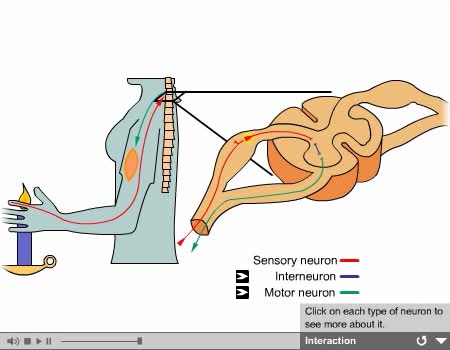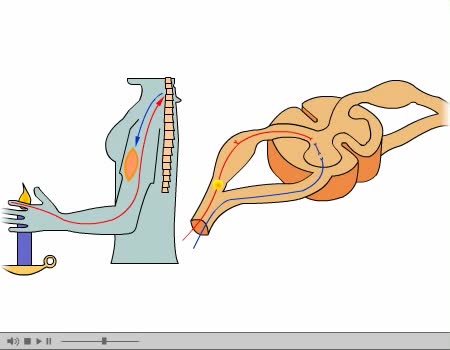Autonomic Nervous System Animation
By: Administrator
Date Uploaded: 05/02/2019
Tags: ANS
Attachments: image.png (22KB) image.png (57KB) image.png (57KB) image.png (53KB) image.png (49KB) image.png (34KB) image.png (54KB) image.png (45KB) image.png (57KB)
Parasympathetic Division Works to conserve energy and innervate the digestive system. When activated, it: stimulates the salivary and digestive glands. decreases the metabolic rate. slows the heart rate. reduces blood pressure. promotes the passage of material through the intestines along with absorption of nutrients by the blood. Sympathetic Division Just outside the spinal cord, axons of these nerve cells leave the spinal nerves and enter almost immediately into masses of nerve-cell bodies, the sympathetic ganglia, which form a chain that runs next to the vertebral column. This chain of about 23 ganglia runs from the base of the head to the coccyx and is known as the sympathetic trunk. Sympathetic Division Within the ganglia of the sympathetic trunk, fibers from the spinal nerves synapse with ganglionic nerve cell bodies, which produce long axons that reach to the parts of the body to be innervated. This arrangement creates a two-neuron chain, as opposed to single-neuron control of regular motor nerves. Sympathetic Division Because of the arrangement in which sympathetic fibers from spinal nerves synapse with many cell bodies in the sympathetic ganglia, they tend to produce widespread innervation when activated. Sympathetic Division This condition prepares the individual for fight or flight: increased alertness, metabolic rate, respiration, blood pressure, heart rate, and decreased digestive and urinary function. A corresponding warming of the body can activate sweat glands. The adrenal gland releases epinephrine (adrenaline), the hormone that causes the familiar adrenaline rush. Parasympathetic Division Very long fibers branching from cranial nerves III, VII, IX, and X along with long fibers of sacral nerves II, III, and IV. Cell bodies for these long fibers are located in the brain and spinal cord. These long fibers extend to ganglia located near the organs to be innervated. Parasympathetic Division Works to conserve energy and innervate the digestive system. When activated, it: stimulates the salivary and digestive glands. decreases the metabolic rate. slows the heart rate. reduces blood pressure. promotes the passage of material through the intestines along with absorption of nutrients by the blood.
Add To
You must login to add videos to your playlists.
Advertisement












Comments
0 Comments total
Sign In to post comments.
No comments have been posted for this video yet.